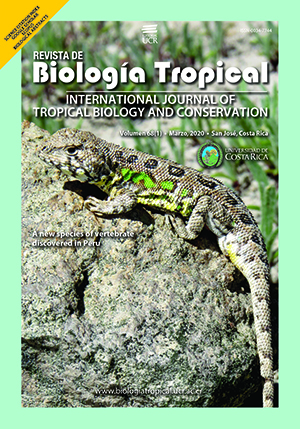Abstract
Introduction: Most of the New World members of the Loranthaceae comprise a clade that corresponds to the tribe Psittacantheae. Previous studies on floral anatomy and development in this tribe have concentrated on the highly diversified subtribe Psittacanthinae, while the smaller subtribe Ligarineae has received less attention. A detailed anatomical description of Tristerix longebracteatus helps to fill this information gap. Objetive: The present research analyzes the anatomy of Tristerix longebracteatus flowers, detailing the structure of androecium and gynoecium, including megasporogenesis and microsporogenesis. Methodology: Anatomical serial sections of flowers at different stages of development were prepared, following processing with fixation techniques, incorporation in paraffin, microtome sectioning and staining with Astra-blue and basic fuchsin. Results: The large-sized flowers of Tristerix longebracteatus present a complex pattern of vascularization with 18-20 vascular bundles at the base of the inferior ovary. A group of three vascular bundles irrigate the 4-5 petals and associated stamens, and ten bundles continue through the gynoecium. The androecium is composed of four or five anthers with simultaneous microsporogenesis. The gynoecium as a single ovarian cavity with a central mamelon in which the archesporial tissue is oriented towards the style. The base of the style forms a nectary similar to that found in the sister genus Ligaria. Conclusions: The gynoecium with a single ovarian cavity and central mamelon is a condition shared by Tristerix (subtribe Ligarinae) and all the genera of the subtribe Psittacanthinae, except Tripodanthus. The base of the style forms a nectary similar to that found in the sister genus Ligaria. This type of stylar nectary is of taxonomic value for grouping species of the subtribe Ligarinae and difers from the annular nectary of subtribe Psittacanthinae.
References
Amico, G. C., Vidal-Russell, R. & Nickrent, D. L. (2007). Relationships and ecological speciation influence of Tristerix (Loranthaceae): the influence of pollinators, dispersers, and host. American Journal of Botany, 94(4), 558-567.
Brown, R. H., Nickrent, D. L., & Gasser, C. S. (2010). Expression of ovule and integument-associated genes in reduced ovules of Santalales. Evolution and Development, 12(2), 231-240.
Cid Villamil, R. M. (2006). Biología del desarrollo de Cladocolea loniceroides (Van Tieghem) Kuijt (Loranthaceae) (Doctoral dissertation). Universidad Nacional Autónoma de México, México, DF, México.
Cocucci, A. E. (1982). El óvulo y el gineceo en Loranthaceae. Boletín de la Sociedad Argentina de Botánica, 218(1-4), 131-141.
Cocucci, A. E. (1983). New evidence from embryology in angiosperm classification. Nordic Journal of Botany, 3(1), 67-73.
Contero, R., & Dehesa, M. A. (2007). Estudio etnobotánico del “mingari” : Tristerix longebracteatus (Desr.) Barlow & Wiens. La Granja: Revista de Ciencias de la Vida, 6(2), 25-29.
Dueñas-Gómez, H. C., & Franco-Roselli, P. (2001). Sinopsis de las Loranthaceae de Colombia. Caldasia, 23, 81-99.
Galetto, L., Bernardello, L. M., & Juliani, H. R. (1990). Acerca del nectario, nectar y visitantes florales en Ligaria cuneifolia (Loranthaceae). Darwiniana, 30, 155-161.
González, F., & Pabón, N. (2017). Inflorescence and floral traits of the colombian species of Tristerix (Loranthaceae) related to hummingbird pollination. Anales del Jardín Botánico de Madrid, 74(2), e061.
Graves, G. R. (1982). Pollination of a Tristerix mistletoe (Loranthaceae) by Diglossa (Aves, Thuraupidae). Biotropica, 14(4), 316-317.
Johri, M., Ambegaokar, B., & Srivastava, S. (1992). Comparative Embryology of Angiosperms. Berlin: Springer-Verlag.
Kuijt, J. (1975). The genus Cladocolea (Loranthaceae). Journal of the Arnold Arboretum, 56(3), 265-335.
Kuijt, J. (1988). Revision of Tristerix (Loranthaceae). Systematic Botany Monographs, 19, 1-61.
Kuijt, J. (1990). A second species of Ligaria (Loranthaceae). Brittonia, 42(1), 66-69.
Kuijt, J. (2015). Santalales. In J. Kuijt & B. Hansen (Eds.), The families and genera of vascular plants, (Vol. 12) Flowering plants: Eudicots; Santalales, Balanophorales (pp. 1-189). Springer: Switzerland.
Kuijt, J., & Weberling, F. (1972). The flower of Phthirusa pyrifolia (Loranthaceae). Berichte der Deutschen Botanischen Gesellschaft, 85(7‐9), 467-480.
Narayana, R. (1958). Morphological and embryological studies in the family Loranthaceae - Lysiana exocarpi (Behr) Van Tieghem. Phytomorphology, 8, 146-168.
Nickrent, D. L., Anderson, F., & Kuijt, J. (2019). Inflorescence evolution in Santalales: integrating morphological characters and molecular phylogenetics. American Journal of Botany, 106(3), 1-13.
Nickrent, D. L., Malécot, V., Vidal-Russell, R., & Der, J. P. (2010). A revised classification of Santalales. Taxon, 59(2), 538-558.
Raj, B. (1970). Morphological and embryological studies in the family Loranthaceae-XIII. Amylotheca dictyophleba Van Tiegh. Plant Systematics and Evolution, 118(5), 417-430.
Robles, A., Raz, L., & Marquínez, X. (2015). Floral anatomy of Peristethium leptostachyum (Loranthaceae). Revista de Biologia Tropical, 64(1), 341-352.
Schaeppi, H., & Steindl, F. (1942). Blütenmorphologische und embryologische Untersuchungen an Loranthoideen. Vierteljahrsschr Naturf Ges Zürich, 87, 301-337.
Suaza, V., Pabón, N., & González, F. (2016). Development and morphology of flowers in Loranthaceae. International Journal of Plant Sciences, 177, 559-578.
Sylvester, S. P., Sylvester, M. D., & Kessler, M. (2014). The world’s highest vascular epiphytes found in the Peruvian Andes. Alpine Botany, 124(2), 179-185.
Venturelli, M. (1981). Estudos sobre Struthanthus vulgaris Mart.: anatomia do fruto e semente e aspectos de germinaçao, crescimento e desenvolvimento. Revista Brasileira de Botánica, 4, 131-147.
Venturelli, M. (1983). Estudos embriológicos em Loranthaceae: Gênero Tripodanthus. Kurtziana, 16, 71-90.
Venturelli, M. (1984a). Estudos embriológicos em Loranthaceae: Struthanthus flexicaulis Mart. Revista Brasileira de Botánica, 7, 107-119.
Venturelli, M. (1984b). Morfologia e anatomia floral de Struthanthus vulgaris Mart. (Loranthaceae) Revista Brasileira de Botánica, 7, 121-128.
##plugins.facebook.comentarios##

This work is licensed under a Creative Commons Attribution 4.0 International License.
Copyright (c) 2020 Xavier Marquínez-Casas, Laura-Alejandra Lamilla, Camila-Andrea Robayo, Felipe Castaño, Lauren Raz






